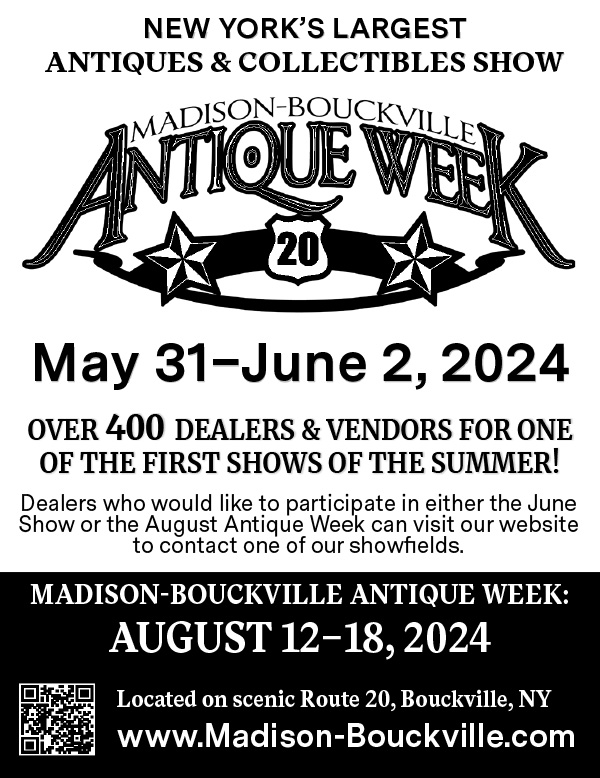Buying antiques at auction can be fun and sometimes results in a bargain. If you haven’t bought at auction before, here are some tips.\r\nGo to the preview prior to the auction, and go as early as possible if there are a number items you may want to bid on. At most auctions everything is sold “as is.” Sometimes an auctioneer will mention if there is a defect in an item, but usually not. It’s up to you to examine things.\r\nIf you listen to the pre-auction announcements often you will hear that the item belongs to you when it is sold. That means if it gets dropped by you or a neighbor or taken by someone, you will still have to pay for it. Many auctions now put you bidder number on the item and takes it to a secure area where you will present your paid receipt to pick up your purchase. That avoids the possibility of loss.
That brings up the bidder number. You will need to register to bid and that generally requires identification such as a driver’s license. You will receive a card or paddle with your number that you will use to bid. Be sure you also know what type of payment is acceptable before you start buying. Also know that most auctions require you to pay a buyer’s premium, a percentage of the “hammer” price. It’s typically from 10 to 22 percent. That can make a difference, especially on big-ticket purchases. It’s not always easy to do the math in your head while bidding, but don’t forget the bottom line is going to be more than you high bid.\r\nWhen your item comes up be sure to listen to the auctioneer, especially if the “lot” has multiple items. It may be that the bid is “so much apiece for the lot.” That means the high bidder must take all items, with the price multiplied by the number of items in the lot. So if the bid is $10 and there are 10 items, you owe $100.\r\nA multi-item lot may be offered as “high bidder has choice.” That means the high bidder can choose from among the items and take some or all, paying the piece price for each one taken. Sometimes the “back bidder” will be given the opportunity to buy at the high bid price if the high bidder does not take all in the lot. After that the remaining items may be offered to the audience, or put up for bid again in the same way or offered as the remaining lot.
When there are multiple items in a lot, be sure you know the terms. That set of four chairs might seem like a bargain until you realize that you bid per chair rather than for the set!\r\nToday many “live auctions” include bids from Internet auction sites, so your competition isn’t limited to the folks in the room. Also auctioneers take phone bids and “left bids” (absentee bids) where the auctioneer or a member of his or her crew bids for the absent bidder. So don’t think the auctioneer is pulling a fast one when you don’t see someone’s paddle in the air.\r\nAs far as bidding is concerned, each auctioneer has his or her own style. An old-fashioned auctioneer is likely to be pretty fast and it take a little getting used to hear what has been bid and what is being asked. It also takes a little getting used to know when the items is about to be sold. Going once, going twice, going three times is not very common. So pay attention to the sale while waiting for your item.\r\nThe auctioneer will take the first bid he sees and then look for more bidders. He may engage several bidders in rotation or may concentrate on two until one drops out, then pick out another to continue the competition. It really doesn’t matter because either the price will be higher than you want when it’s your turn, or you will bid until you win or drop out. Auctioneers typically tell you, it doesn’t matter where it starts, it’s where it finishes that counts. If you think you are being missed, an audible “yes” may be in order. Auctioneers won’t let you raise your own bid.
The important thing is to be seen when you want to bid. That means getting your paddle or card up when you want in. Don’t be half-hearted about it. An auctioneer will typically try to coax another bid from you after you’ve stopped. If you really have changed your mind and want to bid again, don’t wait too long or the item may be sold. That said, it’s a good idea to set your limit and stick within one bid of it at the most. It’s easy to get caught up in the bidding. Don’t think just because someone was willing to pay one bid less doesn’t mean that you paid a fair price. It been known to happen that there were two “crazy” bidders who took an item well past its value.\r\nHere are a few auction etiquette tips. When there are “lot” trays or boxes, don’t move things from one box to another. When you buy a box, you expect to get what you saw in it at the preview. Avoid loud conversations while the auction is on-going. If you must have a cell phone one, put it on silent and take calls away from the auction. Don’t motion to friends or swat at insects; the auctioneer probably won’t make buy a item you raise your hand for, but he or she won’t appreciate the distraction. If you are the successful bidder, make sure the auctioneer can see your bidding number so the auction can keep moving.
Finally, know about what you plan to bid on. Auction “mistakes” usually come about for two reasons. The first is failure to “preview” and second is to buy something without knowledge about the item. Knowing what is old and what is a reproduction or fake, knowing the difference between a first edition book and a later printing, and knowing how much value is lost to a chip or crack or other defect is important. Learning at auction can be expensive.\r\n\r\n





